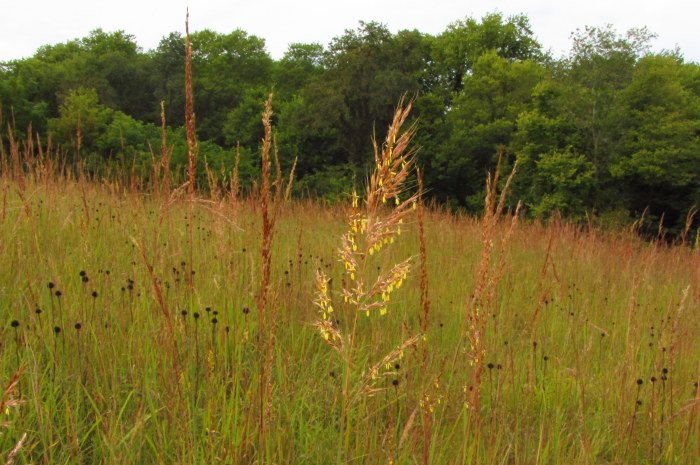During a visit to the never-plowed Tipton Prairie in Greene County earlier this month, I was able to see a native grass at the peak of its blooming period. Indian grass (Sorghastrum nutans) was one of the four dominant species of tallgrass prairies, along with big bluestem, little bluestem, and switchgrass. It was once plentiful across the U.S. and Canada (except for west of the Rocky Mountains) and often thrives in prairie remnants or restorations.
The Illinois Wildflowers and Minnesota Wildflowers sites are good resources for botanically accurate descriptions of the plant parts. Indian grass is easy to identify for its reddish-brown color, spear-shaped spikelets before blooming, and flower clusters with yellow stamens.
I wish I could give a sense of the spectacular landscape. Tipton Prairie spans only about four acres, but in the middle of it, you feel as if you are surrounded by tallgrass prairie. Our guide, Professor Thomas Rosburg of Drake University, speculated that the woodland habitat in the background here probably took hold after European settlement of the area.
We did see both little bluestem and big bluestem at Tipton, but Indian grass seemed more abundant.
Here’s a flowering Indian grass plant in the foreground. Most of the plants in the background are not yet blooming.
Indian grass can reach heights of three to seven feet. Here’s a shorter specimen in the foreground.
Some of the plants in this shot are near the upper end of the height range.
I had trouble getting clear images of the florets, so I’m bringing in the photographers with better skills and better cameras. Wendie Schneider took the next three pictures of Indian grass in Story County during the summer of 2016.
Katie Byerly posted this shot of Indian grass in northeast Iowa.
We now return to my pictures from Tipton Prairie. Indian grass surrounds the field thistle plants that are providing a resting place for this grasshopper.
Compass plants that have finished blooming tower over other grasses and forbs.
Indian grass is blooming on the left side. The plants with black, round tops are pale purple coneflower, which typically blooms in June or July. Next year I hope to visit Tipton at high summer to see these wildflowers at their peak.
Near the bottom of the frame, foliage of leadplant that has gone to seed. This species is on my list to cover in the summer of 2020. You usually only see it in native prairies or high-quality restorations.
Some of the Indian grass visible here has finished flowering and gone to seed.
UPDATE: Reader and educator Steve Peterson shared this blog post he wrote in 2014, after having his students closely examine Indian grass.
At first, the children only saw the stem and the seed head. Some saw the leaves, but these thin strips don’t look like what they are used to calling leaves. The more they looked, though, the more parts they saw. […]
Some saw how the large structures they noticed first (the long stem, for instance) are actually made from ever smaller structures, and these were made from even smaller structures, and so on. The more you looked, the more you saw. […]
Some saw patterns in the way the leaves came off the stem. Some, even wondered whether you could even call these leaves, since it looked like they were at one time part of the stem. Is a leaf a leaf? A stem a stem? When does one become the other? […]
When the children got to this stage in our investigation, it seemed to me that something special was happening. I told them that they were noticing things that only people who study plants, who look very closely at them, notice. And they were asking questions that no one knows the answer to, but scientists are very interesting in knowing these answers. “What, exactly, causes a plant to stop growing up and start to grow a seed head? What causes anything to change? What causes you to change? To grow?” These are important questions, important observations. I congratulated them.
















1 Comment
Unless those are oak trees back there in the photos...
…and I can’t tell what they are, I’m mentally itching to get chainsaws going (along with a little herbicide for the cut stumps) and start pushing that treeline back so prairie plants can reclaim their place. Now that we Iowans are rowcropping just about every acre that can be rowcropped, woody invasion is probably the biggest single reason original prairie remnants are still disappearing.
In general, if we want to help and increase Iowa’s native biodiversity, we should be planting more (native) trees and shrubs in urban areas and cutting more trees and shrubs in rural areas. I certainly don’t mean cutting down the oak savannas and floodplain woodlands that were originally here. I mean working to reduce the vast (and to wildlife biologists, terrifying) mass of invasive shrubs and trees, especially non-natives, that are steadily taking over our natural areas.
Oak savannas and wetlands are ecologically going down under the woody onslaught, as well as prairies. And the land that badly needs work includes a lot of public land. There are examples everywhere. Iowa has many good land managers who know exactly what needs to be done and how to do it, but they are stuck with small budgets, limited staff, and difficult priority decisions.
Rant over. I do appreciate seeing these delicate grass flowers, which are just as lovely as larger flowers in their own small special ways. And I have special fondness for Indian grass because it was one of the first prairie plants I ever learned. And the seed is very easy to collect and soft on the fingers.
PrairieFan Thu 26 Sep 5:51 PM